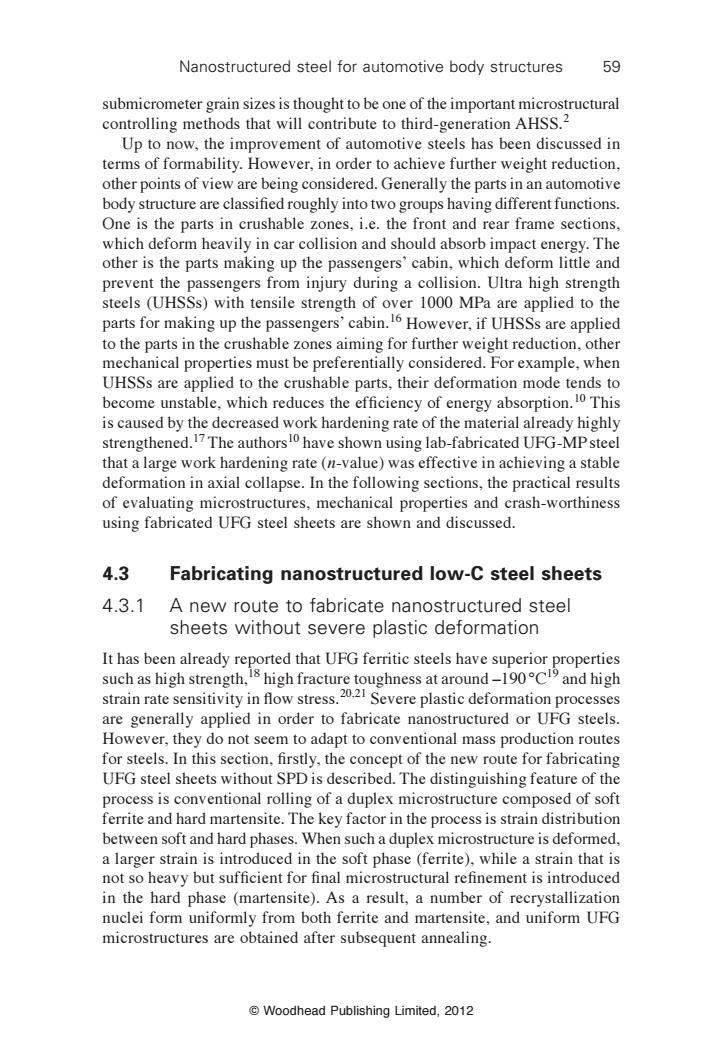正在加载图片...

Nanostructured steel for automotive body structures 59 submicrometer grain sizes is thought to be one of the important microstructural controlling methods that will contribute to third-generation AHSS.2 Up to now,the improvement of automotive steels has been discussed in terms of formability.However,in order to achieve further weight reduction, other points of view are being considered.Generally the parts in an automotive body structure are classified roughly into two groups having different functions. One is the parts in crushable zones,i.e.the front and rear frame sections, which deform heavily in car collision and should absorb impact energy.The other is the parts making up the passengers'cabin,which deform little and prevent the passengers from injury during a collision.Ultra high strength steels (UHSSs)with tensile strength of over 1000 MPa are applied to the parts for making up the passengers'cabin.6 However,if UHSSs are applied to the parts in the crushable zones aiming for further weight reduction,other mechanical properties must be preferentially considered.For example,when UHSSs are applied to the crushable parts,their deformation mode tends to become unstable,which reduces the efficiency of energy absorption.10This is caused by the decreased work hardening rate of the material already highly strengthened.17The authors10 have shown using lab-fabricated UFG-MPsteel that a large work hardening rate(n-value)was effective in achieving a stable deformation in axial collapse.In the following sections,the practical results of evaluating microstructures,mechanical properties and crash-worthiness using fabricated UFG steel sheets are shown and discussed. 4.3 Fabricating nanostructured low-C steel sheets 4.3.1 A new route to fabricate nanostructured steel sheets without severe plastic deformation It has been already reported that UFG ferritic steels have superior properties such as high strength,8 high fracture toughness at around-190Cand high strain rate sensitivity in flow stress.20.21 Severe plastic deformation processes are generally applied in order to fabricate nanostructured or UFG steels. However,they do not seem to adapt to conventional mass production routes for steels.In this section,firstly,the concept of the new route for fabricating UFG steel sheets without SPD is described.The distinguishing feature of the process is conventional rolling of a duplex microstructure composed of soft ferrite and hard martensite.The key factor in the process is strain distribution between soft and hard phases.When such a duplex microstructure is deformed, a larger strain is introduced in the soft phase (ferrite),while a strain that is not so heavy but sufficient for final microstructural refinement is introduced in the hard phase (martensite).As a result,a number of recrystallization nuclei form uniformly from both ferrite and martensite,and uniform UFG microstructures are obtained after subsequent annealing. Woodhead Publishing Limited,2012Nanostructured steel for automotive body structures 59 © Woodhead Publishing Limited, 2012 submicrometer grain sizes is thought to be one of the important microstructural controlling methods that will contribute to third-generation AHSS.2 Up to now, the improvement of automotive steels has been discussed in terms of formability. However, in order to achieve further weight reduction, other points of view are being considered. Generally the parts in an automotive body structure are classified roughly into two groups having different functions. One is the parts in crushable zones, i.e. the front and rear frame sections, which deform heavily in car collision and should absorb impact energy. The other is the parts making up the passengers’ cabin, which deform little and prevent the passengers from injury during a collision. Ultra high strength steels (UHSSs) with tensile strength of over 1000 MPa are applied to the parts for making up the passengers’ cabin.16 However, if UHSSs are applied to the parts in the crushable zones aiming for further weight reduction, other mechanical properties must be preferentially considered. For example, when UHSSs are applied to the crushable parts, their deformation mode tends to become unstable, which reduces the efficiency of energy absorption.10 This is caused by the decreased work hardening rate of the material already highly strengthened.17 The authors10 have shown using lab-fabricated UFG-MP steel that a large work hardening rate (n-value) was effective in achieving a stable deformation in axial collapse. In the following sections, the practical results of evaluating microstructures, mechanical properties and crash-worthiness using fabricated UFG steel sheets are shown and discussed. 4.3 Fabricating nanostructured low-C steel sheets 4.3.1 A new route to fabricate nanostructured steel sheets without severe plastic deformation It has been already reported that UFG ferritic steels have superior properties such as high strength,18 high fracture toughness at around –190 °C19 and high strain rate sensitivity in flow stress.20,21 Severe plastic deformation processes are generally applied in order to fabricate nanostructured or UFG steels. However, they do not seem to adapt to conventional mass production routes for steels. In this section, firstly, the concept of the new route for fabricating UFG steel sheets without SPD is described. The distinguishing feature of the process is conventional rolling of a duplex microstructure composed of soft ferrite and hard martensite. The key factor in the process is strain distribution between soft and hard phases. When such a duplex microstructure is deformed, a larger strain is introduced in the soft phase (ferrite), while a strain that is not so heavy but sufficient for final microstructural refinement is introduced in the hard phase (martensite). As a result, a number of recrystallization nuclei form uniformly from both ferrite and martensite, and uniform UFG microstructures are obtained after subsequent annealing